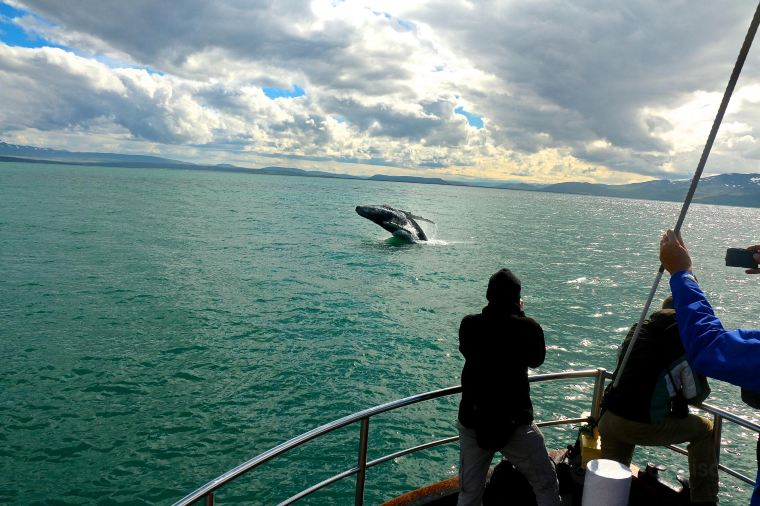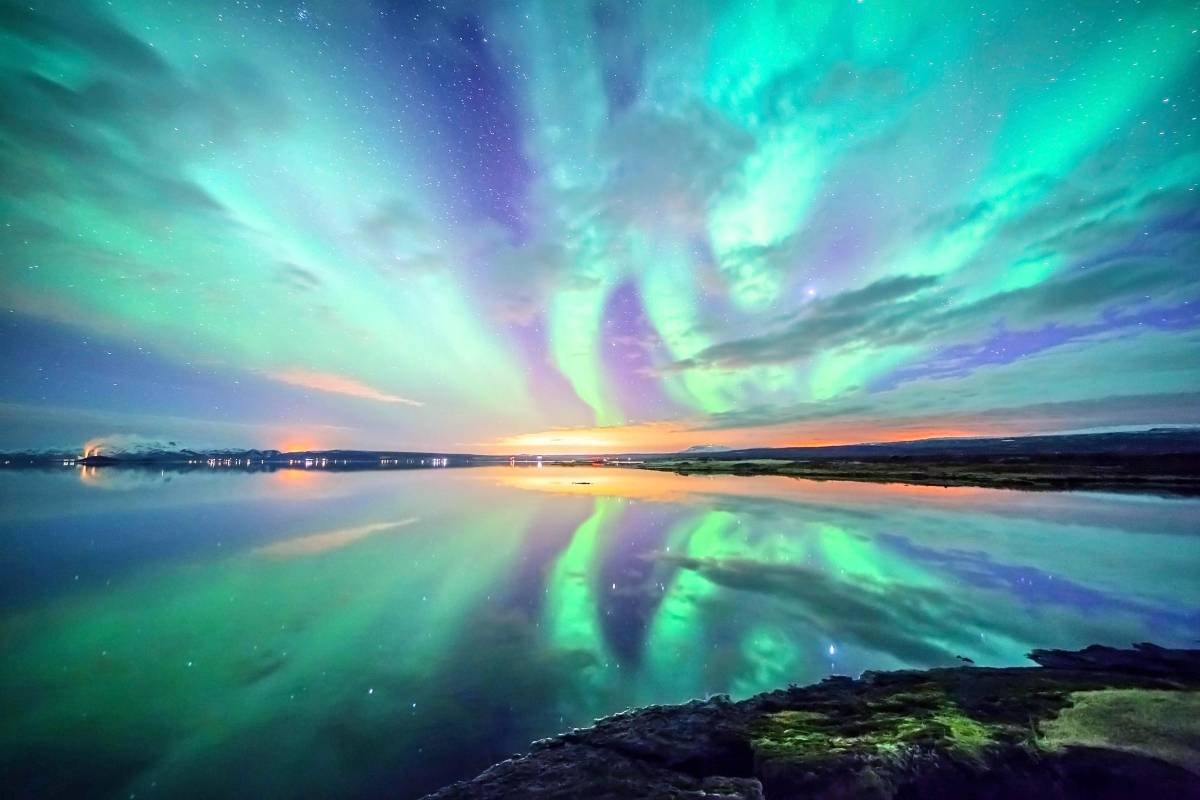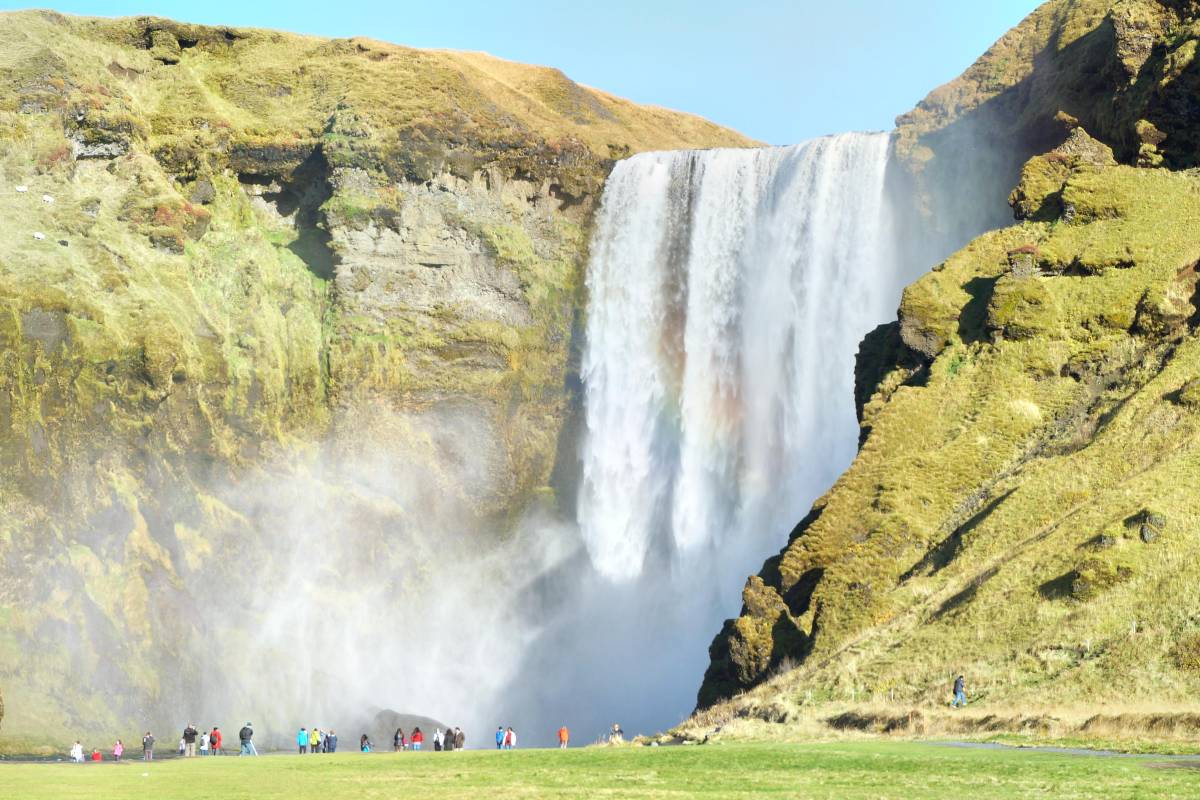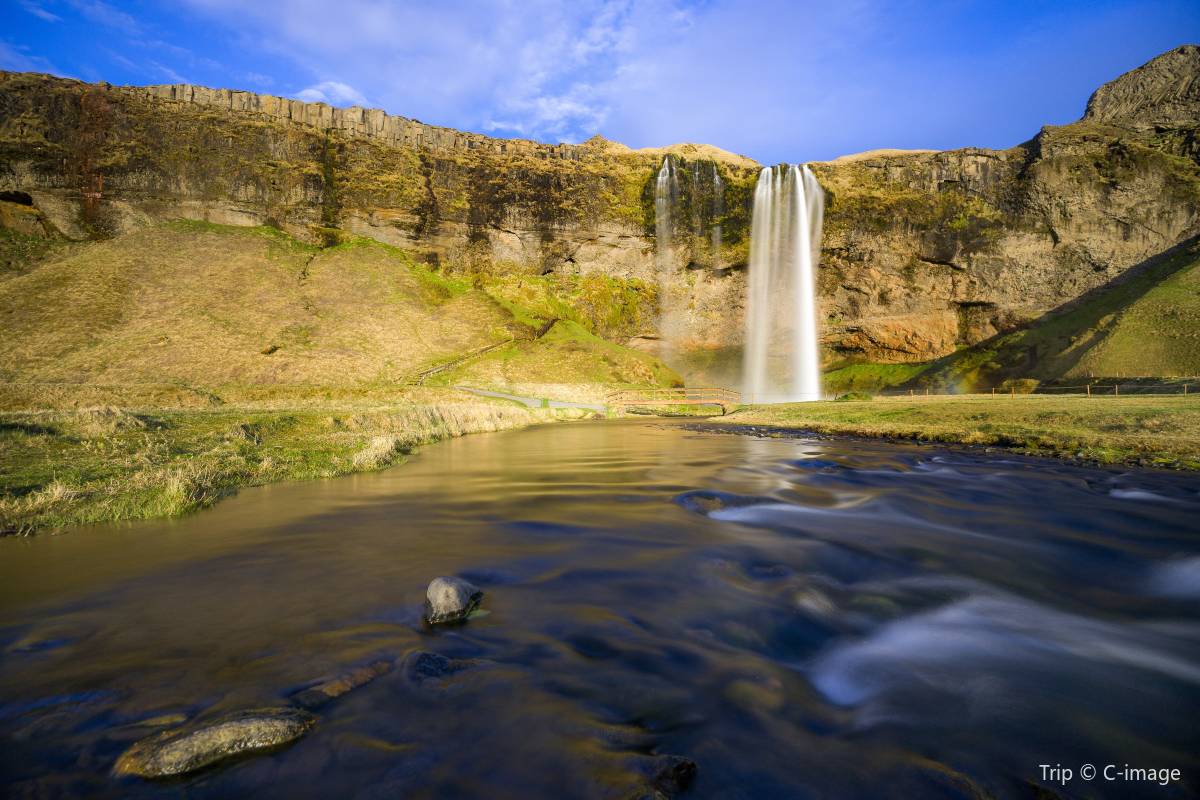Iceland, the land of fire and ice, sits just below the Arctic Circle, where dramatic landscapes meet an equally unpredictable climate. 🌋❄️ Despite its name, Iceland isn’t a frozen wasteland—thanks to the warming influence of the Gulf Stream, it enjoys a relatively temperate oceanic climate. But don’t be fooled! Weather here is famously fickle, changing from sunshine to snowstorm in minutes.
Summers are mild, with temperatures reaching 13–20°C (55–68°F) on warm days, while winters, though chilly, are not as extreme as you might expect, rarely dropping below -1 to -10°C (30–14°F) in populated areas. However, fierce winds and snowstorms can make it feel much colder. 🌬️
Weather & Seasons in Iceland
Summer (June–August)

Weather: The warmest months of the year bring long days—actually, almost endless daylight thanks to the Midnight Sun! 🌞 Temperatures hover between 8–15°C (46–59°F), though inland areas and fjords can get slightly warmer. Expect moderate rainfall and some wind, but overall, it’s the most stable season.
What to wear:
🧥 Lightweight but warm layers—temperatures fluctuate throughout the day.
👕 A t-shirt or light sweater for milder days.
🥾 Waterproof hiking boots—there’s plenty of adventure waiting!
🕶️ Sleep mask—unless you’re okay with 24-hour daylight!
Best seasonal activities:
🚗 Road-tripping the famous Ring Road under clear skies.
🏞️ Exploring waterfalls, black sand beaches, and glaciers with ease.
🐋 Whale watching in Húsavík—summer is peak season! 🐋
🔥 Soaking in geothermal pools like the Blue Lagoon and Sky Lagoon.
🎵 Attending the Secret Solstice Music Festival in Reykjavik.
Travel tip: Even in summer, always pack a rain jacket! A sudden shower or gusty wind can surprise you at any time. ☔💨
Autumn (September–November)

Weather: September still feels like late summer, but by October, cooler air sweeps in, and daylight hours shrink. Expect 2–10°C (35–50°F), with increasing wind and rain. November sees the first proper snowfall, especially in the north.
What to wear:
🧣 Cozy sweaters and thermal base layers.
🧥 A windproof and waterproof jacket—autumn storms are no joke! 🌬️
🥾 Sturdy, waterproof boots for muddy and icy trails.
Best seasonal activities:
🌌 Northern Lights hunting—from late September, the auroras start dancing! 💚💜
🏔️ Hiking in Þórsmörk before the deep snow sets in.
🍁 Enjoying Iceland’s golden autumn landscapes, especially in Thingvellir National Park.
🎶 Experiencing Iceland Airwaves, a world-famous music festival in November.
Travel tip: Autumn is a shoulder season, meaning fewer tourists and lower prices—perfect for budget travelers! 💰
❄️ Winter (December–February)

Weather: This is when Iceland truly earns its icy reputation. ❄️ Expect short days (as little as 4 hours of daylight in December), -1 to -10°C (30–14°F) temperatures, and frequent snowstorms. The wind chill can make it feel even colder, and roads often get icy or closed due to blizzards. 🌨️
What to wear:
🧤 Full winter gear—heavy coat, hat, gloves, scarf, and thermal layers!
🥾 Insulated, waterproof boots—trust me, frozen toes are no fun.
🕶️ Sunglasses—yes, even in winter! Snow glare can be intense.
Best seasonal activities:
🌌 Chasing the Northern Lights—this is peak season! 🌠
🚙 Exploring ice caves—the stunning blue ice caves open to visitors! 🏔️
🎿 Skiing or snowboarding in Akureyri (Iceland’s winter sports hub).
🎄 Experiencing a magical Icelandic Christmas, with folklore about the mischievous Yule Lads.
Travel tip: If renting a car, make sure it’s a 4x4 with studded winter tires. Iceland’s winter roads are no joke! 🚙❄
🌷 Spring (March–May)

Weather: Spring is a mixed bag—March still feels like winter, but by late April, temperatures creep up to 5–12°C (41–54°F). Snow melts in lower regions, and longer daylight hours return. Rain and strong winds are common, but it’s a beautiful time of transition.
What to wear:
🧥 A waterproof and windproof jacket—spring can be wet and unpredictable.
🧦 Layered clothing—mornings can be freezing, afternoons mild.
🥾 Waterproof boots—there’s still slush and mud from melting snow.
Best seasonal activities:
🌿 Seeing Iceland’s waterfalls at their most powerful—snowmelt means roaring cascades!
🐦 Birdwatching—puffins start arriving on the cliffs in late April! 🐧
🛶 Kayaking in fjords or around Reykjavik as the ice recedes.
🏕️ Enjoying fewer crowds at hot springs and popular spots.
Travel tip: Spring is another shoulder season, meaning cheaper flights and fewer tourists. Great time to explore before the summer rush! ✈️
🌏 Best Time to Visit Iceland - Month-by-Month Guide
Iceland’s weather changes dramatically throughout the year, shaping travel experiences in unique ways.❄️ Winter (Dec–Feb) is perfect for Northern Lights and winter adventures. 🌷 Spring (Mar–May) brings melting snow, waterfalls, and fewer crowds. ☀️ Summer (Jun–Aug) offers 24-hour daylight—ideal for road trips. 🍂 Autumn (Sep–Nov) is a golden, mild season with Northern Lights returning.
No matter when you visit, Iceland’s beauty is wild and unforgettable. Let’s dive into each month!
Month | Temp (°C/°F) | Rainfall | Travel Insights |
|---|---|---|---|
Jan ❄️ | -3 to 2°C (27–36°F) | 75mm (3in) | Peak Northern Lights season! Short days (4-5 hrs), icy roads—pack warm layers. |
Feb ❄️ | -2 to 3°C (28–37°F) | 80mm (3.1in) | Great for ice caves & winter adventures. Still cold, but longer daylight (7-9 hrs). |
Mar 🌌 | -1 to 5°C (30–41°F) | 85mm (3.3in) | Spring begins! More daylight, but still snowy. Icelandic Beer Festival 🍻. |
Apr 🌿 | 1 to 7°C (34–45°F) | 65mm (2.6in) | Puffins return! Waterfalls at peak flow, better road conditions. |
May 🌸 | 4 to 10°C (39–50°F) | 55mm (2.2in) | Perfect for budget travel! 15+ hrs of daylight, mild weather. |
Jun ☀️ | 7 to 13°C (45–55°F) | 50mm (2in) | Midnight Sun! Almost 24 hrs of daylight—ideal for road trips & hiking. |
Jul ☀️ | 9 to 15°C (48–59°F) | 50mm (2in) | Warmest month. Peak tourism—book early! Great for whale watching. 🐋 |
Aug 🎉 | 8 to 14°C (46–57°F) | 60mm (2.4in) | Still great weather! Reykjavík Culture Night & Pride Festival. |
Sep 🍂 | 5 to 11°C (41–52°F) | 70mm (2.8in) | Best mix of autumn colors & Northern Lights. Fewer crowds. |
Oct 🌌 | 2 to 7°C (36–45°F) | 85mm (3.3in) | Auroras return! First snowfall, strong winds—pack layers! |
Nov ❄️ | -1 to 4°C (30–39°F) | 90mm (3.5in) | Quiet & dark, but great for Northern Lights. Iceland Airwaves Festival. 🎶 |
Dec 🎄 | -3 to 2°C (27–36°F) | 95mm (3.7in) | Christmas magic & wild New Year’s Eve fireworks! ❄️🎆 Shortest days (4-5 hrs). |
Grab Flight Discounts To Iceland
- Satu Arah
- Pulang-Pergi
 CGK14:5551h 45m2 stopsKEF11:40Jakarta - Reykjavik|Sel, 16 Des|Oman AirKWD 96KWD 12926% OFF26% OFFKWD 129KWD 96
CGK14:5551h 45m2 stopsKEF11:40Jakarta - Reykjavik|Sel, 16 Des|Oman AirKWD 96KWD 12926% OFF26% OFFKWD 129KWD 96 CGK04:2536h 50m2 stopsKEF10:15Jakarta - Reykjavik|Sen, 19 Jan|Malaysia AirlinesKWD 101KWD 12922% OFF22% OFFKWD 129KWD 101
CGK04:2536h 50m2 stopsKEF10:15Jakarta - Reykjavik|Sen, 19 Jan|Malaysia AirlinesKWD 101KWD 12922% OFF22% OFFKWD 129KWD 101 CGK15:5034h 15m2 stopsKEF19:05Jakarta - Reykjavik|Rab, 10 Des|IndiGoKWD 105KWD 12919% OFF19% OFFKWD 129KWD 105
CGK15:5034h 15m2 stopsKEF19:05Jakarta - Reykjavik|Rab, 10 Des|IndiGoKWD 105KWD 12919% OFF19% OFFKWD 129KWD 105 JKT1:00 PM3h 5mLangsungREK2:00 PMJakarta - Reykjavik|Sun, Dec 14|Oman AirTemukan Penerbangan LainnyaTemukan Penerbangan Lainnya
JKT1:00 PM3h 5mLangsungREK2:00 PMJakarta - Reykjavik|Sun, Dec 14|Oman AirTemukan Penerbangan LainnyaTemukan Penerbangan Lainnya
Harga yang dicoret dihitung berdasarkan harga rata-rata rute terkait di Trip.com.
🏔️ Crowds, Costs & Festivals: Choosing the Right Time to Visit Iceland
Iceland is breathtaking year-round, but when you visit makes a huge difference in costs, crowds, and experiences. Whether you want Midnight Sun road trips, Northern Lights adventures, or budget-friendly travel, here’s a detailed guide to when to visit Iceland based on tourism seasons, prices, and festivals.
Peak Season (June – August) 🌞

☀️ Why It’s Peak Season:
- Best weather of the year—mild temperatures, no snow, and almost 24 hours of daylight thanks to the Midnight Sun.
- Perfect for road trips, hiking, and exploring Iceland’s highlands, which are only accessible in summer.
- Iceland’s biggest festivals and events happen during these months.
💰 Crowds & Costs:
- Most expensive time for flights, hotels, and car rentals—prices double or even triple compared to off-peak months.
- Tourist hot spots are packed—expect long lines at places like Blue Lagoon, Skogafoss, and Thingvellir National Park.
- Camping & campervan travel is in high demand—book well in advance!
✅ Pros:
✔️ Perfect weather—no icy roads, longer daylight hours.
✔️ Best time for whale watching and puffins. 🐋🐦
✔️ Highland roads (F-roads) are open for exploring Iceland’s remote areas.
✔️ Midnight Sun = no need to rush—you can hike at 10 PM!
❌ Cons:
❌ Everything is expensive—hotels, tours, and car rentals book up fast.
❌ Crowded attractions—expect packed tourist spots.
❌ Mosquito-like midges (in certain areas like Lake Mývatn).
🎯 Smart Travel Hacks:
- Book flights, hotels, and car rentals 6+ months in advance.
- Visit popular spots early morning or late night (thanks to the Midnight Sun).
- Go off the beaten path—Westfjords and East Iceland are less crowded.
2️⃣ Shoulder Season (May & September) 🍃

🌤 Why It’s the Best Balance:
- Fewer tourists, better prices, and still great weather.
- Puffins (May) & Northern Lights return (September).
- Autumn colors in September make landscapes even more stunning.
💰 Crowds & Costs:
- Flights & hotels are cheaper than summer but still in demand.
- Fewer crowds at top spots like Seljalandsfoss & Skogafoss waterfalls.
✅ Pros:
✔️ Good weather, longer daylight, and lower prices.
✔️ More affordable car rentals & accommodations.
✔️ Best time for photography—wildflowers in May, golden autumn in Sept.
❌ Cons:
❌ Some highland roads may still be closed in May.
❌ Weather is less predictable—September can be windy.
🎯 Smart Travel Hacks:
- Book rental cars & hotels early to get the best deals.
- Visit in mid-to-late September for fall colors + Northern Lights.
- Dress in layers—weather changes fast!
3️⃣ Off-Peak Season (October – April) ❄️

🌌 Why It’s the Quietest Time:
- Darkest months = prime Northern Lights viewing.
- Lowest prices on flights, hotels, and rentals.
- Icelandic winter landscapes = unreal beauty.
💰 Crowds & Costs:
- Cheapest time to visit Iceland! 💰
- Fewer tourists = empty waterfalls, peaceful landscapes.
✅ Pros:
✔️ Best time for Northern Lights (Oct – Mar).
✔️ Ice caves & glacier hikes are only available in winter!
✔️ Cozy, festive vibes in December—Christmas markets & New Year’s Eve fireworks. 🎆
❌ Cons:
❌ Short daylight hours (as little as 4-5 hours in Dec/Jan).
❌ Icy roads & unpredictable weather—not ideal for first-time winter drivers.
🎯 Smart Travel Hacks:
- Stick to guided tours if you’re not comfortable driving on ice.
- Plan activities around daylight hours—maximize your time outdoors.
- Wear layers, waterproof boots, and a solid winter jacket.
4️⃣ Major Festivals & Events That Impact Travel
📅 Month | 🎉 Event & Festival | 📝 Description |
January – February | ✨ Þorrablót Festival | Traditional Icelandic midwinter feast with unique local dishes. 🥩 |
March – April | 🎶 Icelandic Beer Festival | Celebration of Iceland’s best craft beers, held in Reykjavík. 🍻 |
June | 🌞 Secret Solstice Festival | Music festival featuring international artists under the Midnight Sun. 🎶 |
August | 🎭 Culture Night (Menningarnótt) | Reykjavík’s biggest cultural festival with art, music, and fireworks. 🎨🎆 |
October – November | 🎶 Iceland Airwaves | One of Iceland’s top music festivals, showcasing local and international acts. 🎵 |
December | 🎄 Christmas & New Year’s Eve | Festive holiday celebrations with dazzling fireworks in Reykjavík. 🎆🎅 |
🏔️ Best Time to Visit Iceland Based on Your Travel Style 🇮🇸
Iceland is a year-round destination, but the best time to visit depends on your travel style. Whether you’re chasing budget deals, luxury stays, outdoor adventures, cultural experiences, or family-friendly trips, here’s when to go for the best experience.
1️⃣ Budget Travelers 💰✈️
📅 Best Months: October – April (Except December Holidays)
If you’re traveling on a budget, winter and early spring are your best bets. Flights and hotels are at their lowest, and you’ll find deals on tours and car rentals compared to peak season. The only exception? December holidays, when prices jump for Christmas and New Year's Eve.
💸 Why These Months?
- Cheapest flights—round-trip airfare to Reykjavík is often 40-50% cheaper than summer prices.
- Hotels and rentals drop in price, especially outside Reykjavík.
- Car rentals are much cheaper—except 4x4s, which are still in demand.
💡 Money-Saving Tips:
✅ Book flights 2-4 months in advance for the best winter deals.
✅ Consider guesthouses and Airbnb instead of hotels for lower rates.
✅ Eat at gas station diners or grocery stores—restaurants are pricey year-round.
✅ Stick to free activities like hiking, waterfalls, and Northern Lights hunting instead of expensive guided tours.
2️⃣ Luxury Travelers ✨🛎️
📅 Best Months: June – August & December
For a luxurious experience, visit in summer for ideal weather and exclusive private tours, or in December for a magical Christmas and New Year’s Eve celebration.
🏩 Why These Months?
- Perfect weather for private yacht tours, helicopter rides, and luxury road trips.
- Michelin-starred restaurants in Reykjavík are in full swing.
- Premium lodges and hotels (like The Retreat at Blue Lagoon) are in high demand.
- December offers magical holiday vibes, with cozy boutique stays and private Northern Lights tours.
💡 Luxury Travel Tips:
✅ Book high-end accommodations (like The Retreat at Blue Lagoon) at least 6 months ahead.
✅ Reserve Michelin-starred restaurants early—Dill and ÓX book out fast.
✅ Hire a private guide for glacier hikes, snowmobiling, or helicopter sightseeing.
✅ Upgrade to premium Blue Lagoon tickets for exclusive access to private lagoons.
3️⃣ Adventure Seekers 🥾❄️
📅 Best Months: June – September (Hiking & Road Trips) | November – March (Winter Adventures)
Iceland is an adventurer’s paradise year-round, but the best time depends on your activity of choice.
🚙 Summer (June – September) – Best for Hiking & Highlands
- Long daylight hours (up to 24 hours in June-July).
- Highland roads (F-roads) are open for 4x4 off-roading.
- Hike epic trails like Laugavegur, Fimmvörðuháls, and Hornstrandir.
❄️ Winter (November – March) – Best for Ice & Snow Adventures
- Best time for ice caving and glacier hiking in Vatnajökull National Park.
- Ideal conditions for snowmobiling, skiing, and extreme winter 4x4 adventures.
- Peak Northern Lights season.
💡 Adventure Travel Tips:
✅ For hiking, visit in July-August when trails are snow-free.
✅ Rent a 4x4 if you’re exploring the highlands—smaller cars won’t cut it.
✅ For winter activities, book ice cave tours in advance—they sell out fast.
✅ Always check road conditions in winter before heading out solo.
4️⃣ Cultural Enthusiasts 🎭🎶
📅 Best Months: February, June, August, December
Iceland has incredible cultural experiences, from ancient traditions to modern music festivals.
🎉 Best Months for Culture & Festivals
📅 February – Þorrablót Festival – Try traditional Icelandic food. 🥩
📅 June – Secret Solstice Festival – Midnight Sun music festival. 🎶
📅 August – Reykjavík Culture Night & Pride Festival – Biggest city-wide celebrations. 🏳️🌈
📅 December – Christmas & New Year’s Eve – Festive holiday markets and epic fireworks. 🎆
💡 Cultural Travel Tips:
✅ Visit during August for the best city vibes—Reykjavík comes alive.
✅ Book accommodation early for festivals—prices rise fast.
✅ Try fermented shark and Brennivín during Þorrablót if you dare! 😅
✅ Take a guided history tour in Reykjavík to learn about Icelandic sagas.
5️⃣ Family Travelers 👨👩👧👦
📅 Best Months: June – August
If you’re traveling with kids, summer is by far the best time—warmest weather, long daylight, and kid-friendly activities.
👨👩👧👦 Why Summer is Best for Families:
- Mildest weather—easier for young kids to explore.
- Long daylight hours—more sightseeing time with no rush.
- Safe driving conditions for road trips (no icy roads).
- Puffin watching, whale tours, and geothermal pools—great for kids! 🐦🐋
💡 Family Travel Tips:
✅ Visit kid-friendly hot springs like Secret Lagoon or Fontana (hotter than Blue Lagoon).
✅ Plan a Golden Circle self-drive—short and easy routes for families.
✅ Go whale watching in summer—kids love seeing puffins and dolphins.
✅ Pack layers for kids—weather changes quickly, even in summer.
Hotel Recommendation In Iceland
Iceland is one of those places that stays with you long after you leave. Whether you’re chasing the Midnight Sun, standing beneath a roaring waterfall, or watching the Northern Lights dance across the sky, every season has something incredible to offer. Just remember—layers are your best friend, always check the weather, and embrace the unexpected.
Now that you know the best time to visit, it’s time to plan the rest of your adventure! Need a place to stay? Check out our Where to Stay in Iceland guide to find the best neighborhoods and hotels. Looking for itinerary ideas? Explore the Top Things to Do in Iceland for must-see spots and hidden gems.
With the perfect timing in mind, all that’s left is to book your flights, pack your bags, and get ready for an unforgettable trip. Iceland is waiting!✨
FAQs: Common Questions About Visiting Iceland
What’s the best way to get around Iceland?
Renting a car is best if you want to explore beyond Reykjavík. Inside the city, buses work, but taxis are pricey. No Uber or Lyft here!How much does a trip cost?
Budget travelers can manage on $80–$120 per day, mid-range around $200–$300, and luxury $400+. Book early to save!Is Iceland safe?
Very safe! Biggest risks are the weather and nature—check road conditions and stay away from sneaker waves.Where should I stay?
Reykjavík City Center is best for sightseeing. Stay near Laugavegur for nightlife, Vesturbær for a quieter vibe, or along the South Coast for nature.What food should I try?
Grab a lamb hot dog (pylsur) from Bæjarins Beztu. Try plokkfiskur (fish stew) and skyr for a local taste. Hákarl (fermented shark) is for the brave!What’s a common tourist mistake?
Not dressing for the weather—layers are a must! Also, don’t get too close to the waves at Reynisfjara Beach.Do I need cash?
Nope! Credit cards work everywhere, even for small purchases.Is tipping expected?
No, it’s included in prices. Rounding up the bill is nice but not required.What are the best free things to do?
See waterfalls like Gullfoss, explore black sand beaches, soak in hot springs, and hunt for the Northern Lights—all free!

 NO.1
NO.1


